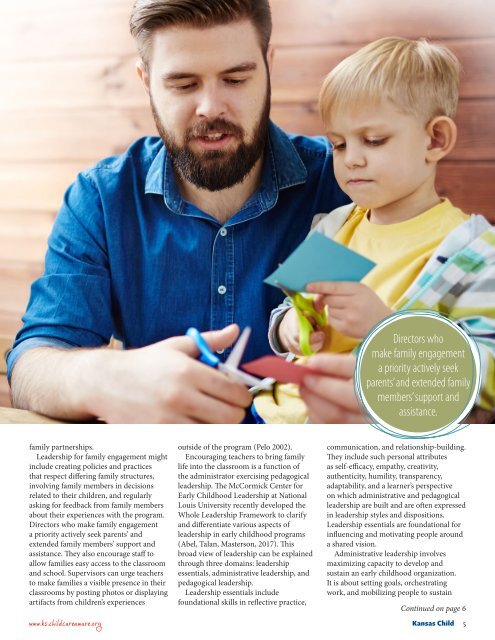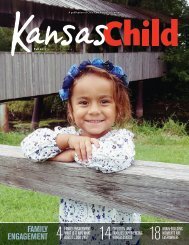2017 Summer Kansas Child
You also want an ePaper? Increase the reach of your titles
YUMPU automatically turns print PDFs into web optimized ePapers that Google loves.
Directors who<br />
make family engagement<br />
a priority actively seek<br />
parents’ and extended family<br />
members’ support and<br />
assistance.<br />
family partnerships.<br />
Leadership for family engagement might<br />
include creating policies and practices<br />
that respect differing family structures,<br />
involving family members in decisions<br />
related to their children, and regularly<br />
asking for feedback from family members<br />
about their experiences with the program.<br />
Directors who make family engagement<br />
a priority actively seek parents’ and<br />
extended family members’ support and<br />
assistance. They also encourage staff to<br />
allow families easy access to the classroom<br />
and school. Supervisors can urge teachers<br />
to make families a visible presence in their<br />
classrooms by posting photos or displaying<br />
artifacts from children’s experiences<br />
outside of the program (Pelo 2002).<br />
Encouraging teachers to bring family<br />
life into the classroom is a function of<br />
the administrator exercising pedagogical<br />
leadership. The McCormick Center for<br />
Early <strong>Child</strong>hood Leadership at National<br />
Louis University recently developed the<br />
Whole Leadership Framework to clarify<br />
and differentiate various aspects of<br />
leadership in early childhood programs<br />
(Abel, Talan, Masterson, <strong>2017</strong>). This<br />
broad view of leadership can be explained<br />
through three domains: leadership<br />
essentials, administrative leadership, and<br />
pedagogical leadership.<br />
Leadership essentials include<br />
foundational skills in reflective practice,<br />
communication, and relationship-building.<br />
They include such personal attributes<br />
as self-efficacy, empathy, creativity,<br />
authenticity, humility, transparency,<br />
adaptability, and a learner’s perspective<br />
on which administrative and pedagogical<br />
leadership are built and are often expressed<br />
in leadership styles and dispositions.<br />
Leadership essentials are foundational for<br />
influencing and motivating people around<br />
a shared vision.<br />
Administrative leadership involves<br />
maximizing capacity to develop and<br />
sustain an early childhood organization.<br />
It is about setting goals, orchestrating<br />
work, and mobilizing people to sustain<br />
Continued on page 6<br />
www.ks.childcareaware.org <strong>Kansas</strong> <strong>Child</strong> 5

















